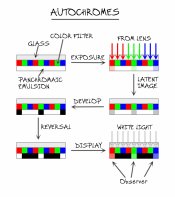JSMOOVE, I'm not sure about the latter, but the former reference is not correct. Steve uploaded examples.
PE
PE
JSMOOVE, I'm not sure about the latter, but the former reference is not correct. Steve uploaded examples.
PE
@jnanian Thanks for the link! I think I was a bit misinformed in how the process works, I don't actually need to make any autochromes myself...was just more curious as to how they workedI found Ianvaag's explanation broke it down for me pretty good. I also found a good breakdown of color photography in my internet journeys last night:
http://dhlab.unibas.ch/documents/archive/color_photography_history.pdf
What I've been most curious about though is if it is possible to project an image onto a one-layer only color emulsion/material, that's sortof why I was curious to learn about the autochrome....was so that I might be able to digitally recreate the filter, and project onto a panchromatic emulsion.
I did find: http://proposal.ducr.u-tokyo.ac.jp/cgi-bin/ccr_usr/EN/detail.cgi?num=3678
A bit hard to understand for me, but would this type of emulsion work for such a thing?

| Photrio.com contains affiliate links to products. We may receive a commission for purchases made through these links. To read our full affiliate disclosure statement please click Here. |
PHOTRIO PARTNERS EQUALLY FUNDING OUR COMMUNITY:  |